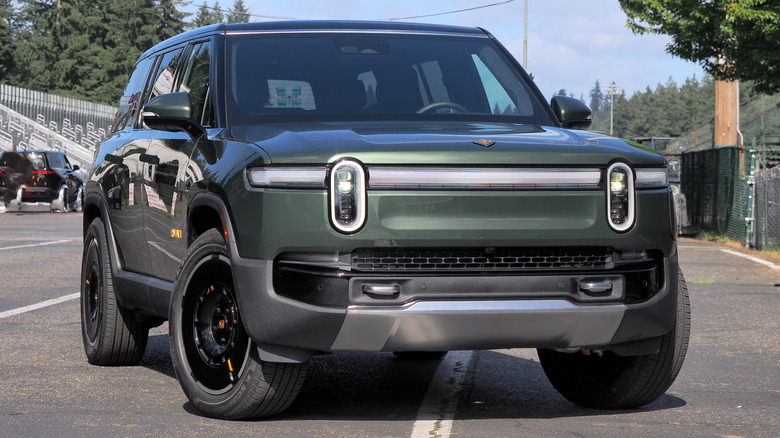
Chris Davies/SlashGear
There’s a whole lot riding on the 2025 Rivian R1S and R1T, even if these second-generation electric trucks don’t look much different from the outside. More powerful and more efficient, the new two, three, and four-motor EVs not only represent meaningful updates as Rivian chases production perfection, but also aim to address some of the feedback (or just complaints) from its earliest adopters.
It could take that strategy, because the R1 got in early. Rivian was the first to launch an all-electric pickup in the U.S. market, and then the first to launch an all-electric three-row SUV. The auto industry doesn’t stand still, however: several big names now have EV trucks, and while three-row electric rivals like the Kia EV9 may not match the R1S for performance or luxury features, they don’t command the same, premium price tag, either.
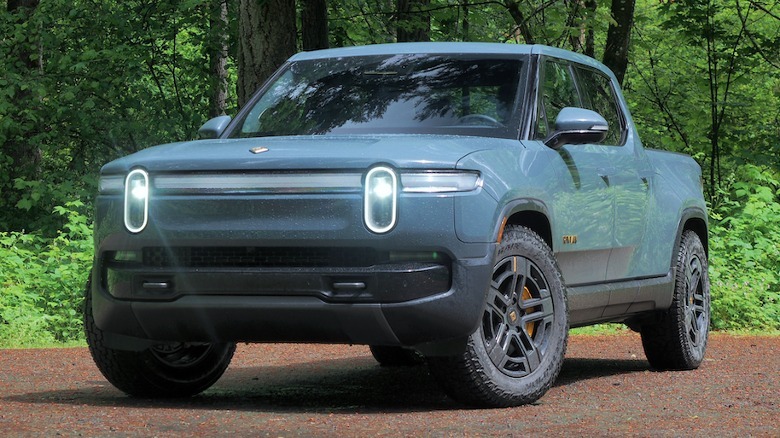
By the time the smaller, cheaper R2 launches in 2026, meanwhile, Rivian certainly won’t have first-mover advantage in the five-seat electric SUV space. And, put bluntly, the R1 needs to be a success to pay for the R2, and then the R2 in turn in order for the smaller-still R3 to be possible.
The original Rivian R1 was always alluring, but the second-generation R1 needs to convince would-be buyers that it can also be a sensible choice.
Spot the difference
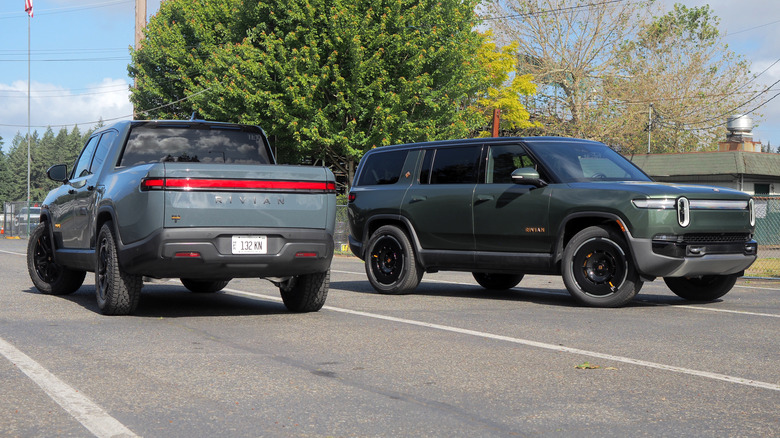
Chris Davies/SlashGear
You’ll need to be eagle-eyed to spot the second-generation SUV and truck: Rivian made few exterior changes. There are fresh 20″ and 22″ wheel designs, with a new super-high performance Summer tire for the fastest quad-motor R1, and a 22-inch range tire that now also roughly matches the sporting capabilities of the old high-performance rubber. A 20-inch entry-level wheel and tire set attempts to straddle both off- and on-road potential, though Rivian will continue to offer a more aggressive off-road wheel (with a dip in range in return for its extra grip).
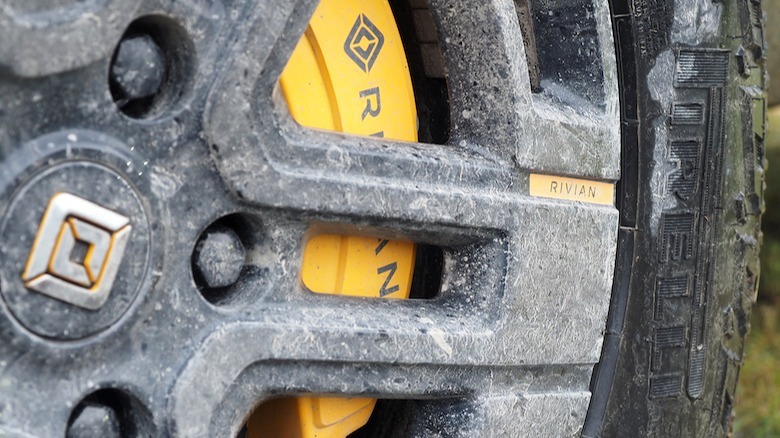
Get up close, though, and you’ll see the distinctive Rivian light bar — which spans nose and tail — has been changed. It’s more three-dimensional in its profile, now, with bolder framing around the upright, pill-shaped headlamps. Those are now filled with matrix LEDs, initially for corner-turning lights which illuminate the bends as you spin the wheel, but later — with regulatory approval and an over-the-air update — for the magical anti-dazzling high-beams that European drivers have been enjoying for some time. Basically, the R1 will selectively turn off those matrix LEDs which would shine on oncoming traffic, rather than the EV flipping between high- and low-beams.
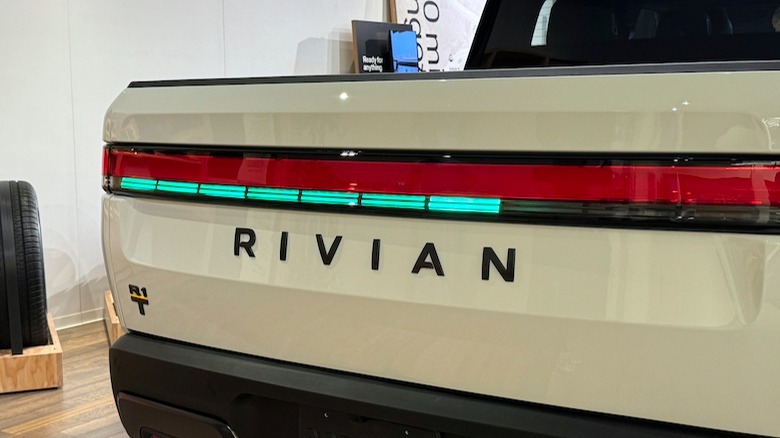
Within the light bars, meanwhile, are new RGB color-changing LEDs. Split into ten segments, they allow Rivian to show battery charging status — in green 10% increments — on the front and the rear of the vehicle, along with animated amber «drive around me» graphics. The automaker has more planned for the LEDs, too, though for now it’s tight-lipped on what that might include. The Tri-Motor gets yellow brake calipers and badging; the Quad-Motor gets blue, with a little badge of Rivian’s yeti character on the trunk.
The cabin goes more upscale
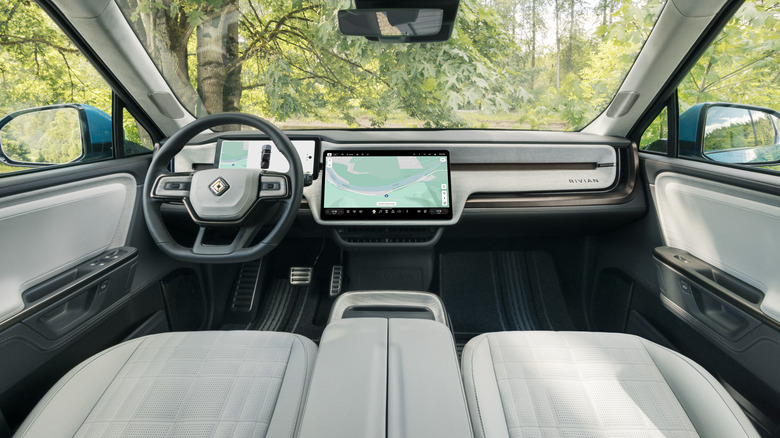
Rivian
Inside, the cabin is a familiar thing. Rather than change switchgear, seats, or cubbies, Rivian is launching three new design packages — with a mixture of open-pore wood, various fabrics, and metal trim pieces — for the three different drivetrain variations. They go with a new blackout package — optional on the dual-motor; standard on the tri- and quad-motor, with the regular bright a no-cost option — that switches the polished trim for a dark finish.
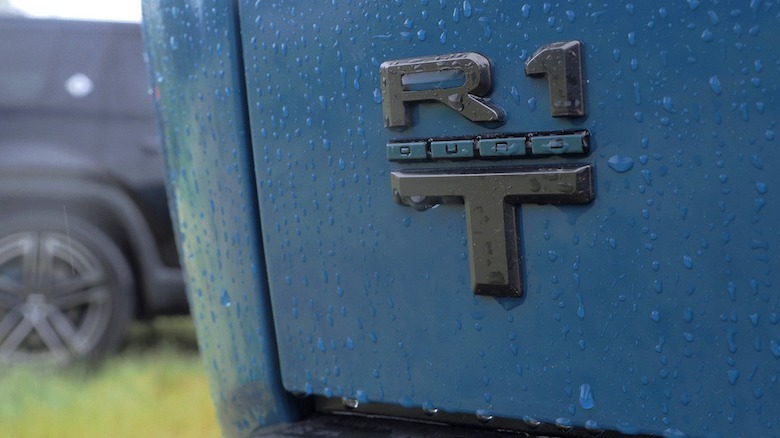
There’s more fabric where once plastic abounded — like on the rear of the seats, and on the door panels and center console — and more playful touches like plaid floor mats and pattern-matching seat stitching. Rivian even has corresponding elastic webbing for the seat and door pockets, a tiny detail likely to be largely overlooked, but a sign that the automaker is mature enough now to be sweating this small stuff.
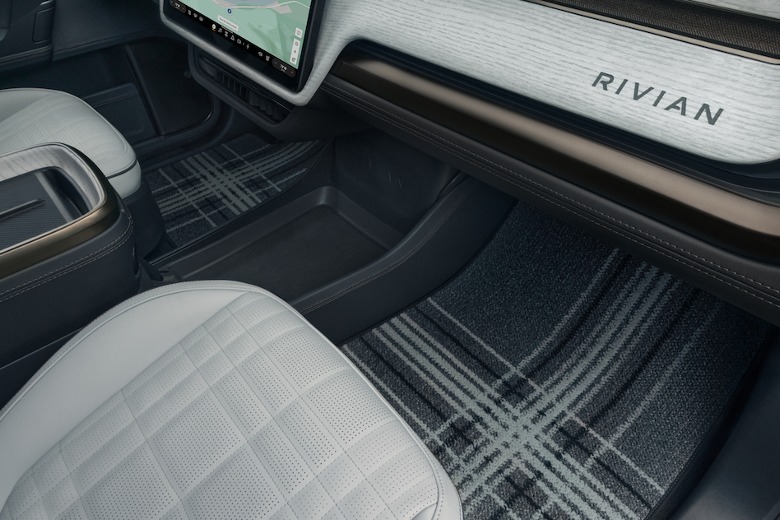
Functionally, the physical door handles are replaced by push-button releases (which could stand to be larger), and there’s an electrochromic tinted glass roof. Customizable ambient lighting supports a number of preconfigured cabin schemes, and there’s a more powerful wireless phone charger with a larger pad, along with ultra-wideband (UWB) digital key support for the iPhone/Apple Watch wallet and select Android phones like Google’s Pixel. That means keyless access, as well as the ability to invite others to use your Rivian with a virtual key. Rivian will only be supplying NFC keycards; later in the year it’ll have an updated (and optional) version of its carabiner-style key fob.
Charming new software
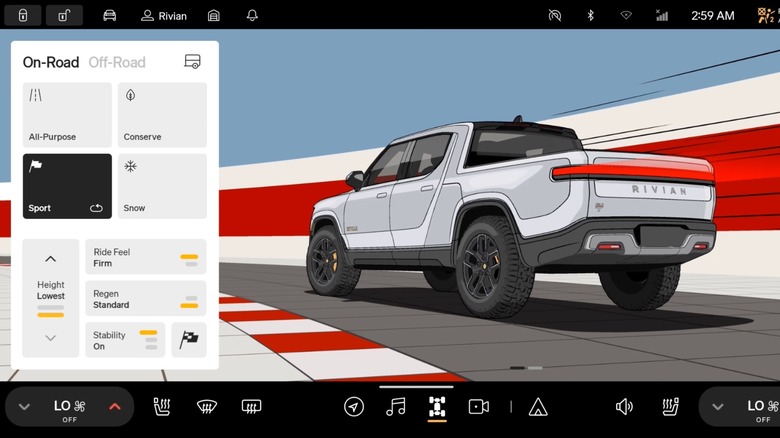
Rivian
Centerpiece of the Rivian dashboard remains a 16-inch landscape orientation touchscreen. First frustration: No, there’s still no Apple CarPlay or Android Auto support. Rivian is hoping, though, that its changes in the second-generation EVs will assuage your fury, there.
There’s a new, cel-shaded interface — effectively rendering the truck and accompanying graphics in an old-school animation style — as Rivian intentionally takes an alternative path to the hyper-realistic 3D vehicle models from other automakers’ UIs. They match the exact color and spec of the R1 you’re driving, and there are charming animations throughout, alongside the more serious goal of making it clearer which drive mode and settings you’re currently using.
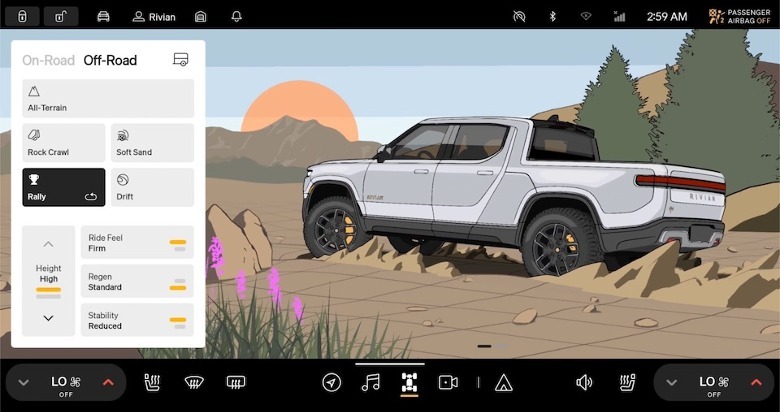
Generally, there’s a focus on making features easier to use and understand, and surfacing interesting details. You can turn on side mirror, steering wheel, and seat heating simply by tapping those graphics in the HVAC interface, for example, and while the front vents are still motorized and can be individually adjusted by dragging a finger around the touchscreen, there are now two sets of dual presets — for driver and front passenger — to save the preferred orientation of the airflow for faster recall. Steering wheel and side mirror adjustments are still more fiddly than they need to be, mind.
Still no CarPlay, but Apple Music is coming
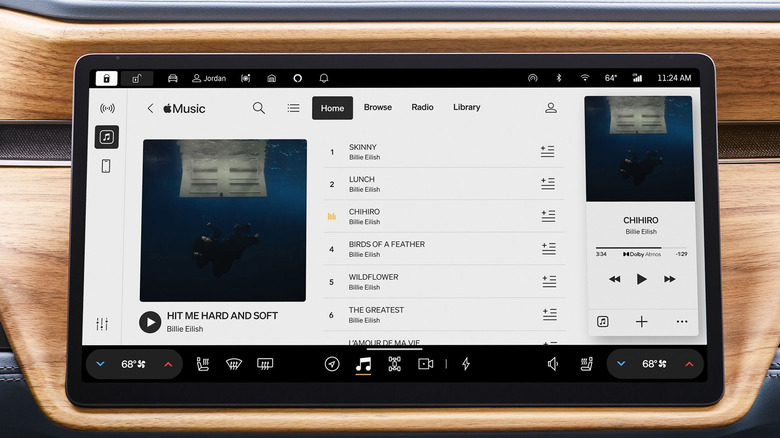
Rivian
As before, there are native apps for streaming services like Spotify and Tidal. Rivian is also adding native Apple Music support, but now they’re all part of a new, paid Connect+ subscription which it hopes will tame some of the «but where’s CarPlay?» complaints. Apple’s streaming looks and operates much like Apple Music on an iPad — despite Rivian’s infotainment being Android-based — with song, playlist, and radio access.
The subscription — which, after a 60 day free trial, is $14.99 per month or $149.99 annually — also includes WiFi hotspot, Google Cast for wirelessly playing content from apps like Amazon Prime (but not, currently, Netflix) from an iOS or Android device on the R1’s touchscreen, and, if you have the Rivian Premium Audio speaker package, Dolby Atmos music support. Initially that’s only on Atmos tracks from Apple Music, but Tidal and Amazon Music are apparently in the pipeline.
Rivian plans to support its new Connect+ subscription on the first-gen R1, and drivers with the Meridian audio system on their EVs will get Atmos support, too. Without a subscription, there’ll be live navigation, digital key, and remote access to the R1 through the Rivian app.
Huge changes under the sheet metal
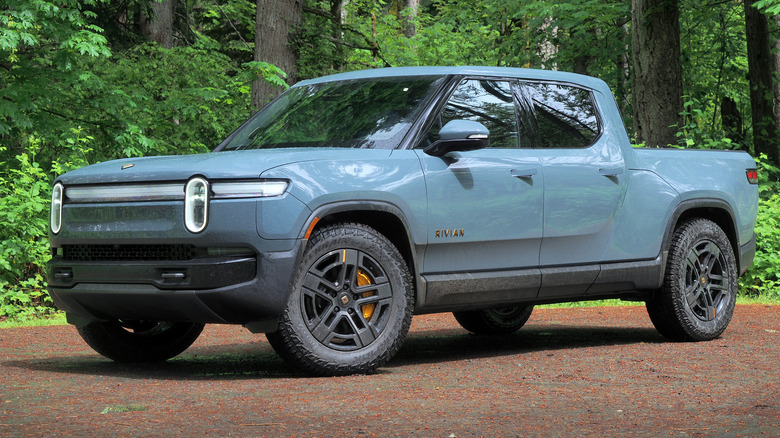
Chris Davies/SlashGear
What the minimal visual changes mask is just how much of the underlying R1 platform is new. Unlike the original quad-motor R1T and R1S, which paired a third-party electric motor with Rivian’s own gearing and other components, the new tri- and quad-motor models use the same, in-house Enduro motor design that debuted on the dual-motor R1 earlier this year.
Enduro is smaller and more efficient, but it also allows Rivian far greater flexibility for how it organizes its EV architecture. The original quad-motor vehicles had pretty much identical motors on the front and rear wheels, but Rivian realized that peak torque was never fully utilized at the front (instead, things like efficiency and sustained power were key). For these second-generation models, the front one or two motors (depending on tri- or quad-motor configurations) are smaller and more efficient during cruising.
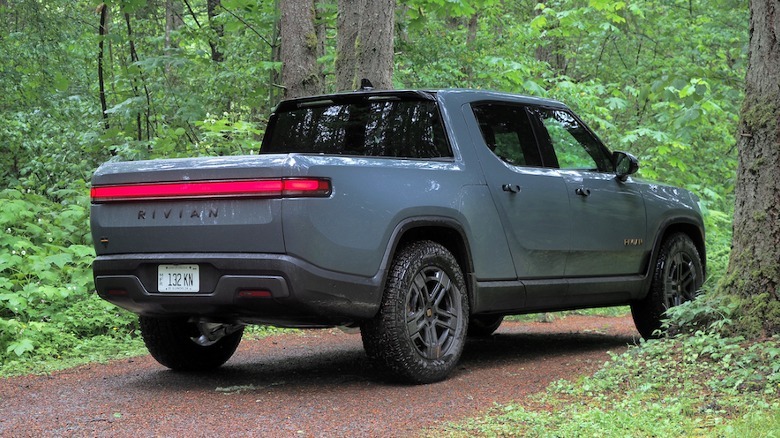
The rear twin-motor drive unit, though, is much larger and geared for maximum torque. A mechanical disconnect can cut it out of the drivetrain, though, to save power when that grunt isn’t necessary, but will bring it back online — even when the R1 is in Rivian’s «Conserve» eco mode — should more aggressive performance be desired.
You want speed? Rivian has speed
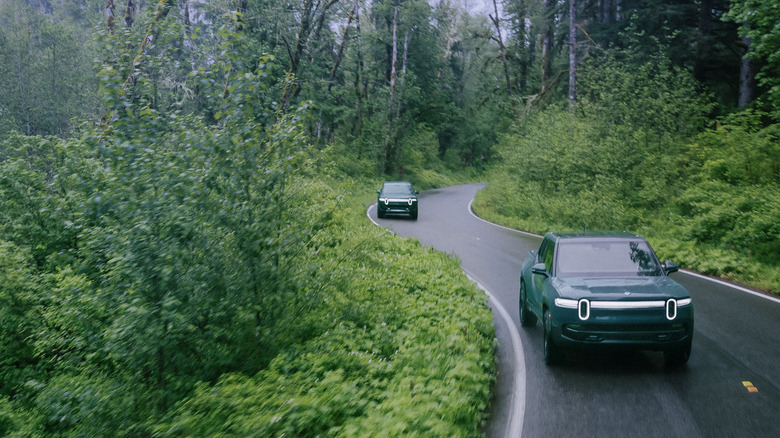
Rivian
The result is, frankly, stupid levels of speed from a pickup or three-row SUV. The 2025 R1 Tri-Motor packs 850 horsepower and 1,103 lb-ft of torque, for a 0-60 mph time of 2.9 seconds. That actually makes it slightly faster than the old quad-motor R1, but still with an estimated 380-410 miles of range.
As you might expect, then, the 2025 R1 Quad-Motor is a bona fide beast (or, conversely, just plain ridiculous). Does an electric truck need 1,025 horsepower and peak 1,198 lb-ft of torque in the new Launch Mode, and to do 0-60 in under 2.5 seconds? Not for any reason other than bragging rights, but that doesn’t mean outlandish capabilities don’t sell in the high-end vehicle segment.
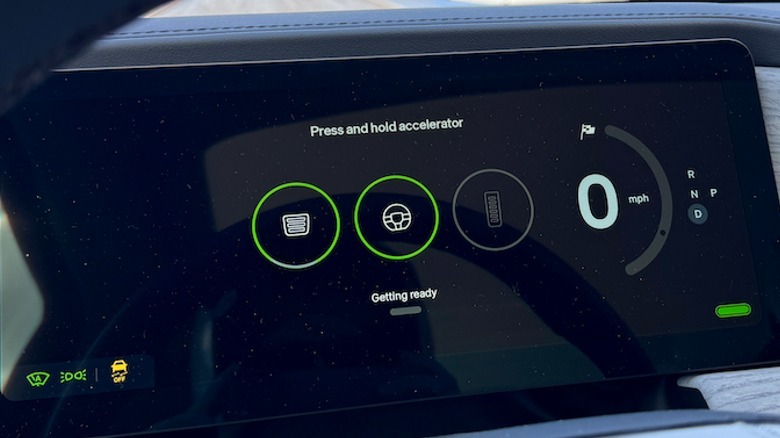
Range is yet to be confirmed for the R1 Quad-Motor, though those wanting maximum driving distance should still opt for the Dual-Motor version. That — with a still-impressive 533 hp and 610 lb-ft in base spec, or 665 hp and 829 lb-ft in Performance form — and Rivian’s Max Pack battery will do 410 miles in the R1S, or 420 miles in the R1T.
A cheaper battery and a lot fewer cables
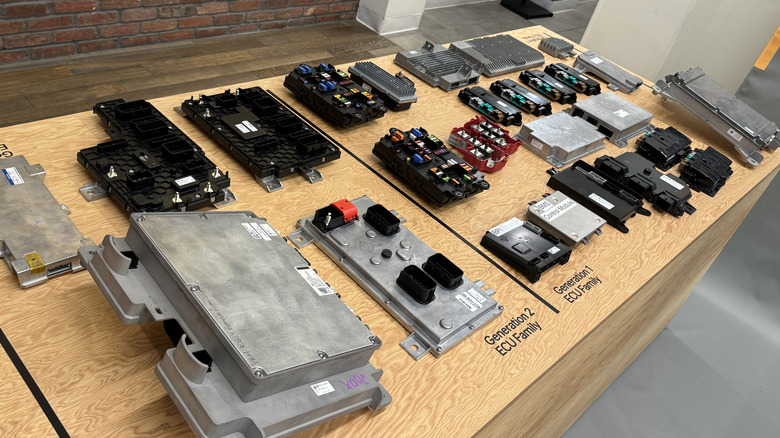
Chris Davies/SlashGear
At the entry-level, though, there’s a brand new Standard battery pack. Fitting into the same battery enclosure as the Large and Max versions — updated to make the redesigned, smaller Battery Management System accessible from underneath the EV, making maintenance roughly an hour job, versus the eight hour «drop out the whole pack» saga — it uses cheaper (and less power dense) lithium iron phosphate chemistry, though Rivian still expects up to 270 miles of EPA range.
For charging, conspicuous by its absence is the NACS (aka Tesla Supercharger) connector that’s due in 2025. The second-generation R1 will still come with a CCS port, adding up to around 140 miles of driving range after 20 minutes plugged in. Supercharger support will be via an adapter.
Linking everything is Rivan’s completely revamped electrical architecture. Now using significantly fewer ECU designs — seven unique models, down from 17 — and 1.6 miles less cabling, it’s not only more efficient but supposedly quicker and cheaper to manufacture. That’s a big deal, when you’re still a relative newcomer trying to build EVs as fast as possible.
The R1S’ biggest flaw is fixed
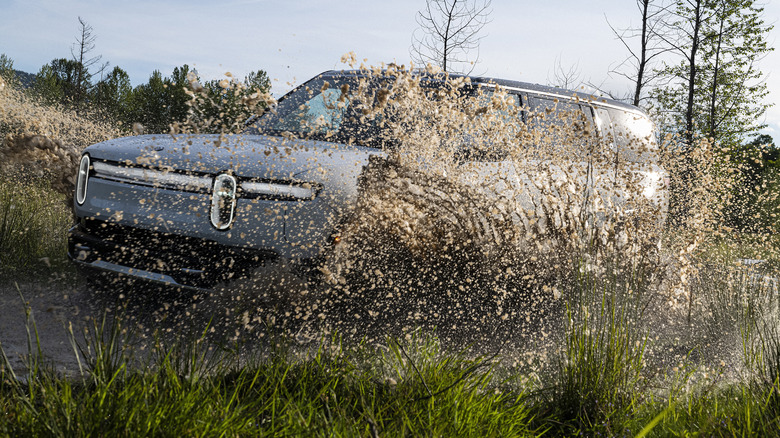
Rivian
On the road, the most important change is to the ride quality, in particular on the R1S. The original — based on the same suspension setup as the R1T, despite the wheelbase difference — could pitch uncomfortably. New air springs, recalibrated rates and a new set of dampers, among other suspension changes, leave the second-gen far more compliant and less jerky on poor-quality surfaces. The updated R1T gets the new dampers, too, though didn’t require the full suite of changes.
It checks off arguably the biggest comfort annoyance, though switch to Sport mode and things firm up considerably. Pair that with the Tri-Motor’s affinity to speed, and you’ve an SUV that can very quickly get you into license-losing territory without you even realizing. Thanks to the low center of gravity and Rivian’s torque vectoring, the big truck sashays neatly down curved and twisting roads. Only its not-inconsiderable scale might make you blink.
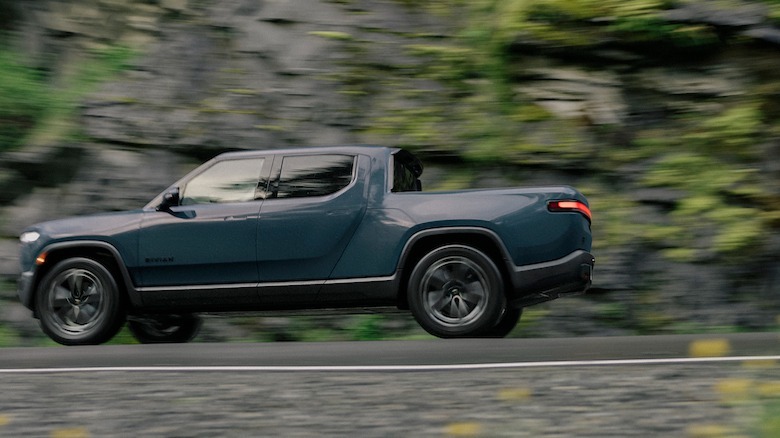
The drift course is hardly a natural habitat for Rivian owners, you have to presume, but it shows the R1S Tri-Motor’s astonishing poise and handling. For an SUV that’s roughly 7,000 pounds, the ability to throw it sideways and — albeit with a fair amount of hauling on the steering wheel — readily control it is hugely impressive. Off-road ventures are almost too easy: even in the base spec R1, it’s a matter of pointing the nose where you want to go and then feathering the accelerator in maximum regen one-pedal mode. None of the pauses or over-compensation that you get with an internal combustion engine, waiting for it to rouse itself, or jumping between gas and brake.
Hands-off driver assist is coming
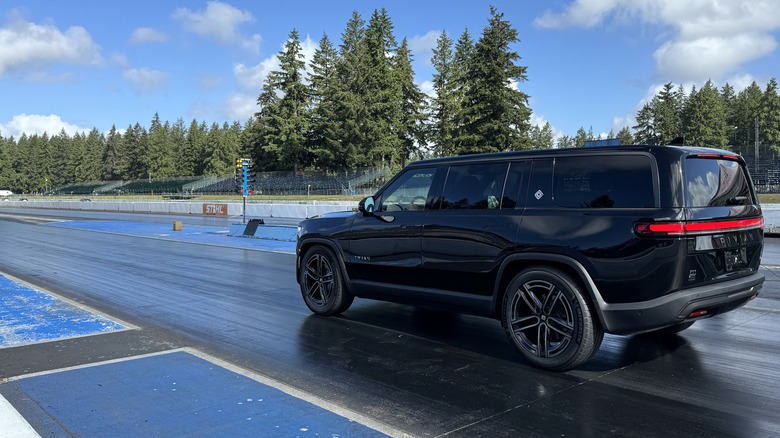
Chris Davies/SlashGear
The original R1S and R1T were hardly lacking, in the grand scheme of current EVs. Still, they’re Rivian’s aspirational options (even if they undercut many of their obvious rivals) and, viewed through that lens, keeping them topped up with power, range, and capability makes a certain sort of sense. It seems likely the even-more-ridiculous new second-generation R1 Quad-Motor will only tighten that spring further: I may have «only» done 0-60 in 2.89 seconds in Launch Mode on the drag strip (Rivian blamed the sticky track surface), but quibbling over that pace, in a vehicle this size, seems churlish.
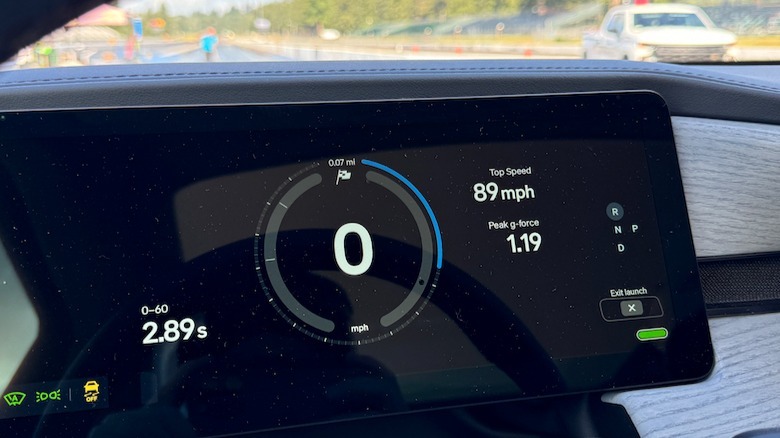
We’ll have to wait to try the Quad on the road, just like we’ll need to wait for Rivian’s new Enhanced Highway Assist system. That will add hands-free adaptive cruise control and lane centering — akin to Ford’s BlueCruise and GM’s Super Cruise — with an attention-tracking camera in the rearview mirror. It’ll work on pre-mapped, limited-access divided highways, and Rivian expects it to go live later in 2024. After that, regular Highway Assist should expand road coverage for Rivian’s hands-on system, including to select non-divided roads.
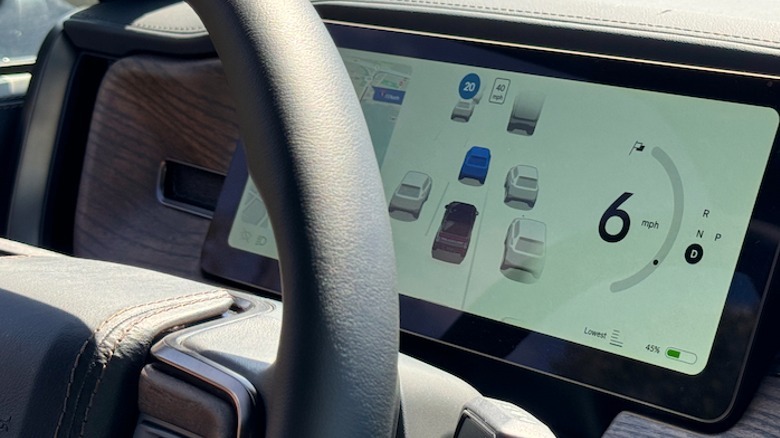
They’re part of the new Rivian Autonomy Platform+ — which will also add lane-change on demand, moving across automatically on highways at the tap of the turn signal — based on a significantly-upgraded autonomy system with a pair of NVIDIA Orin chipsets. It collates data from 11 cameras and five radars around the R1, with (at 250 TOPS) a tenfold processing improvement over the first-gen system, and 8x the total camera megapixels.
There’s plenty of work still to do
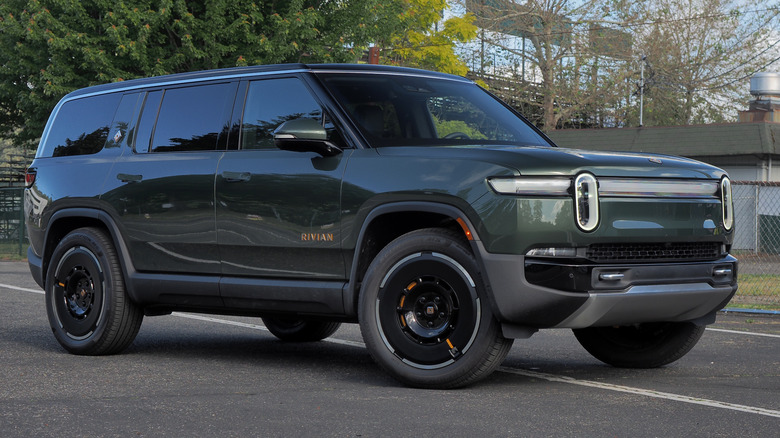
Chris Davies/SlashGear
The big numbers should have real-world impact. Better handling of contrast difference — such as exiting a dark tunnel on a bright day — will give the R1 a stronger understanding the road ahead, while a threefold improvement in detection range should improve performance, particularly in highway conditions. Rivian remains an advocate of the multimode sensor approach — rather than, say, Tesla’s camera-only Autopilot suite — combining camera and radar for greater redundancy. Still, there’s no sign of full autonomy any time soon, the automaker saying it’s more focused on ramp-to-ramp systems that take over boring highway drives.
It’s a caution you see elsewhere in the R1, for better or worse. Bidirectional charging is still hardware supported, but there’s no way to actually use it yet to, say, power a house during an outage. The only way to get power out of the EV currently is via the 110V outlets, which support up to 1.5 kW. Enough for a campsite or key appliances in an emergency, but not to run the whole home like a Ford F-150 Lightning could with the right charger setup.
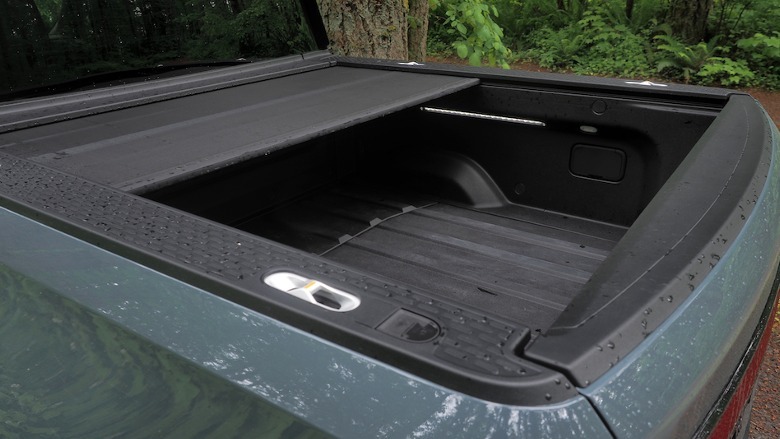
Rivian says that’s still something it’s exploring, but then again its to-do list remains long. One of the advantages of being a relatively youthful automaker with an outspoken clientele is that owner feedback can shape the order that the to-do list is tackled. Monthly OTA updates have delivered new fixes and features, and Rivian plans to bring the new software design and Connect+ to first-gen R1 models. They won’t get Lane Change on Command or other new features that are based on the second-gen Autonomy Platform, mind.
2025 Rivian R1 Verdict
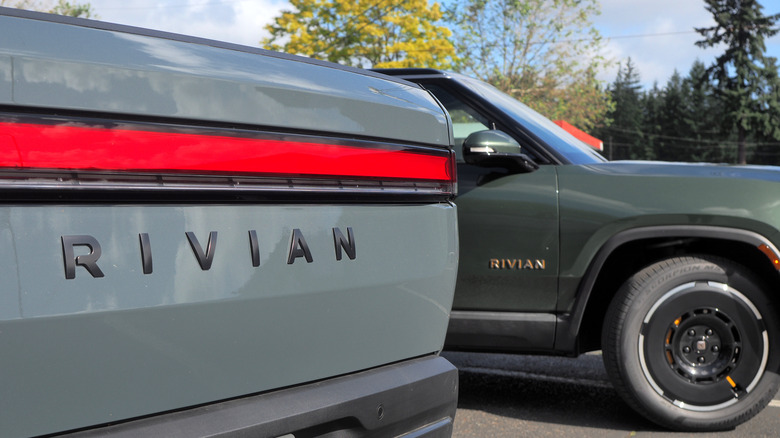
Chris Davies/SlashGear
What the second-generation R1 isn’t, of course, is the $45,000 Rivian R2. For that, we’ll have to wait until 2026, though the automaker is taking reservations now. And the big pickup and three-row SUV are far, far from the «so instantly popular that Rivian seemed genuinely surprised» smaller-still R3 that will follow the R2.
Those models will stand a chance at moving Rivian further into the electric vehicle mainstream. The 2025 R1 duo, in contrast, remain premium models with premium pricing. The Dual-Motor R1T and R1S kick off at $69,900 and $75,900 respectively, with deliveries beginning June 7th. If you want a Tri-Motor R1T, budget $99,900 for the Max pack, or $105,900 for the R1S version. Deliveries are expected to begin of that configuration in the summer; the Quad-Motor R1 should ship at the start of 2025, with pricing yet to be confirmed.
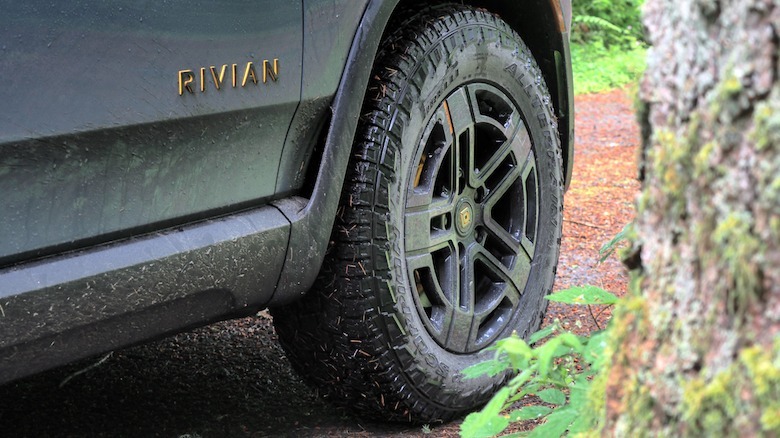
In the echelons of high-performance, well-equipped electric trucks from GMC, Ford, Tesla, and others, those prices aren’t out of line. And Rivian’s offering still straddles the old and new automotive worlds most successfully, I think: neither hung up on truck legacy, like Ford and Chevy are perhaps guilty of; nor relentlessly (and needlessly) futuristic for its own, controversial sake, like a Cybertruck.
Those who can afford it will find the second-generation R1 a better, more efficient, and more rewarding EV. Now Rivian needs to bring that quirky attention-to-detail down to electric vehicles for the broader market, if it’s to fulfill its ambitions of being more than an appealing but niche player.